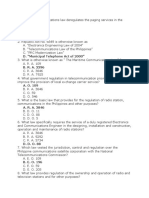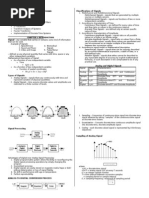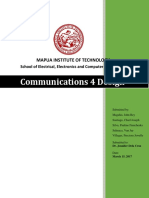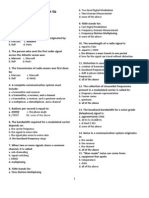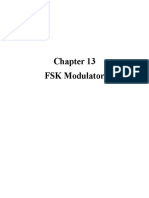Principles of Electronic Communication Systems: Third Edition
Uploaded by
Ma KristinaPrinciples of Electronic Communication Systems: Third Edition
Uploaded by
Ma KristinaPrinciples of Electronic
Communication Systems
Third Edition
Louis Frenzel
McGraw-Hill © 2008 The McGraw-Hill Companies, Inc. All rights reserved.
Chapter 3
Amplitude Modulation Fundamentals
McGraw-Hill © 2008 The McGraw-Hill Companies, Inc. All rights reserved.
Topics Covered in Chapter 3
3-1: AM Concepts
3-2: Modulation Index and Percentage of Modulation
3-3: Sidebands and the Frequency Domain
3-4: AM Power
3-5: Single-Sideband Modulation
3-6: Classification of Radio Emissions
McGraw-Hill © 2008 The McGraw-Hill Companies, Inc. All rights reserved.
3-1: AM Concepts
In the modulation process, the voice, video, or digital
signal modifies another signal called the carrier.
In amplitude modulation (AM) the information signal
varies the amplitude of the carrier sine wave.
The instantaneous value of the carrier amplitude
changes in accordance with the amplitude and
frequency variations of the modulating signal.
An imaginary line called the envelope connects the
positive and negative peaks of the carrier waveform.
McGraw-Hill © 2008 The McGraw-Hill Companies, Inc. All rights reserved.
3-1: AM Concepts
Figure 3-1: Amplitude modulation. (a) The modulating or information signal.
McGraw-Hill © 2008 The McGraw-Hill Companies, Inc. All rights reserved.
3-1: AM Concepts
Figure 3-1: Amplitude modulation. (b) The modulated carrier.
McGraw-Hill © 2008 The McGraw-Hill Companies, Inc. All rights reserved.
3-1: AM Concepts
In AM, it is particularly important that the peak value of
the modulating signal be less than the peak value of
the carrier.
Vm < Vc
Distortion occurs when the amplitude of the
modulating signal is greater than the amplitude of the
carrier.
A modulator is a circuit used to produce AM. Amplitude
modulators compute the product of the carrier and
modulating signals.
McGraw-Hill © 2008 The McGraw-Hill Companies, Inc. All rights reserved.
3-1: AM Concepts
Figure 3-3: Amplitude modulator showing input and output signals.
McGraw-Hill © 2008 The McGraw-Hill Companies, Inc. All rights reserved.
3-2: Modulation Index and
Percentage of Modulation
The modulation index (m) is a value that describes
the relationship between the amplitude of the
modulating signal and the amplitude of the carrier
signal.
m = Vm / Vc
This index is also known as the modulating factor or
coefficient, or the degree of modulation.
Multiplying the modulation index by 100 gives the
percentage of modulation.
McGraw-Hill © 2008 The McGraw-Hill Companies, Inc. All rights reserved.
3-2: Modulation Index and
Percentage of Modulation
Overmodulation and Distortion
The modulation index should be a number between 0
and 1.
If the amplitude of the modulating voltage is higher than
the carrier voltage, m will be greater than 1, causing
distortion.
If the distortion is great enough, the intelligence signal
becomes unintelligible.
McGraw-Hill © 2008 The McGraw-Hill Companies, Inc. All rights reserved.
3-2: Modulation Index and
Percentage of Modulation
Overmodulation and Distortion
Distortion of voice transmissions produces garbled,
harsh, or unnatural sounds in the speaker.
Distortion of video signals produces a scrambled and
inaccurate picture on a TV screen.
McGraw-Hill © 2008 The McGraw-Hill Companies, Inc. All rights reserved.
3-2: Modulation Index and
Percentage of Modulation
Figure 3-4: Distortion of the envelope caused by overmodulation where the
modulating signal amplitude Vm is greater than the carrier signal Vc.
McGraw-Hill © 2008 The McGraw-Hill Companies, Inc. All rights reserved.
3-2: Modulation Index and
Percentage of Modulation
Percentage of Modulation
The modulation index is commonly computed from
measurements taken on the composite modulated
waveform.
Using oscilloscope voltage values:
Vmax − Vmin
Vm =
2
The amount, or depth, of AM is then expressed as the
percentage of modulation (100 × m) rather than as a
fraction.
McGraw-Hill © 2008 The McGraw-Hill Companies, Inc. All rights reserved.
3-2: Modulation Index and
Percentage of Modulation
Figure 3-5: AM wave showing peaks (Vmax) and troughs (Vmin).
McGraw-Hill © 2008 The McGraw-Hill Companies, Inc. All rights reserved.
3-3: Sidebands and
the Frequency Domain
Side frequencies, or sidebands are generated as
part of the modulation process and occur in the
frequency spectrum directly above and below the
carrier frequency.
McGraw-Hill © 2008 The McGraw-Hill Companies, Inc. All rights reserved.
3-3: Sidebands and
the Frequency Domain
Sideband Calculations
Single-frequency sine-wave modulation generates
two sidebands.
Complex wave (e.g. voice or video) modulation
generates a range of sidebands.
The upper sideband (fUSB) and the lower sideband
(fLSB) are calculated:
fUSB = fc + fm and fLSB = fc − fm
McGraw-Hill © 2008 The McGraw-Hill Companies, Inc. All rights reserved.
3-3: Sidebands and
the Frequency Domain
Figure 3-6: The AM wave is the
algebraic sum of the carrier and
upper and lower sideband sine
waves. (a) Intelligence or
modulating signal. (b) Lower
sideband. (c ) Carrier. (d ) Upper
sideband. (e ) Composite AM wave.
McGraw-Hill © 2008 The McGraw-Hill Companies, Inc. All rights reserved.
3-3: Sidebands and
the Frequency Domain
Frequency-Domain Representation of AM
Observing an AM signal on an oscilloscope, you see
only amplitude variations of the carrier with respect to
time.
A plot of signal amplitude versus frequency is referred
to as frequency-domain display.
A spectrum analyzer is used to display the frequency
domain as a signal.
Bandwidth is the difference between the upper and
lower sideband frequencies.
BW = fUSB−fLSB
McGraw-Hill © 2008 The McGraw-Hill Companies, Inc. All rights reserved.
3-3: Sidebands and
the Frequency Domain
Figure 3-8: The relationship between the time and frequency domains.
McGraw-Hill © 2008 The McGraw-Hill Companies, Inc. All rights reserved.
3-3: Sidebands and
the Frequency Domain
Frequency-Domain Representation of AM
Example:
A standard AM broadcast station is allowed to transmit
modulating frequencies up to 5 kHz. If the AM station is
transmitting on a frequency of 980 kHz, what are
sideband frequencies and total bandwidth?
fUSB = 980 + 5 = 985 kHz
fLSB = 980 – 5 = 975 kHz
BW = fUSB – fLSB = 985 – 975 = 10 kHz
BW = 2 (5 kHz) = 10 kHz
McGraw-Hill © 2008 The McGraw-Hill Companies, Inc. All rights reserved.
3-3: Sidebands and
the Frequency Domain
Pulse Modulation
When complex signals such as pulses or rectangular
waves modulate a carrier, a broad spectrum of
sidebands is produced.
A modulating square wave will produce sidebands
based on the fundamental sine wave as well as the
third, fifth, seventh, etc. harmonics.
Amplitude modulation by square waves or rectangular
pulses is referred to as amplitude shift keying (ASK).
ASK is used in some types of data communications.
McGraw-Hill © 2008 The McGraw-Hill Companies, Inc. All rights reserved.
3-3: Sidebands and
the Frequency Domain
Figure 3-11: Frequency spectrum of an AM signal modulated by a square wave.
McGraw-Hill © 2008 The McGraw-Hill Companies, Inc. All rights reserved.
3-3: Sidebands and
the Frequency Domain
Figure 3-12: Amplitude modulation of a sine wave carrier by a pulse or rectangular
wave is called amplitude-shift keying. (a) Fifty percent modulation. (b) One hundred
percent modulation.
McGraw-Hill © 2008 The McGraw-Hill Companies, Inc. All rights reserved.
3-3: Sidebands and
the Frequency Domain
Pulse Modulation
Continuous-wave (CW) transmission can be achieved
by turning the carrier off and on, as in Morse code
transmission.
Continuous wave (CW) transmission is sometimes
referred to as On-Off keying (OOK).
Splatter is a term used to describe harmonic sideband
interference.
McGraw-Hill © 2008 The McGraw-Hill Companies, Inc. All rights reserved.
3-4: AM Power
In radio transmission, the AM signal is amplified by a
power amplifier.
A radio antenna has a characteristic impedance that is
ideally almost pure resistance.
The AM signal is a composite of the carrier and
sideband signal voltages.
Each signal produces power in the antenna.
Total transmitted power (PT) is the sum of carrier
power (Pc ) and power of the two sidebands (PUSB and
PLSB).
McGraw-Hill © 2008 The McGraw-Hill Companies, Inc. All rights reserved.
3-4: AM Power
When the percentage of modulation is less than the
optimum 100, there is much less power in the
sidebands.
Output power can be calculated by using the formula
PT = (IT)2R
where IT is measured RF current and R is antenna
impedance
McGraw-Hill © 2008 The McGraw-Hill Companies, Inc. All rights reserved.
3-4: AM Power
The greater the percentage of modulation, the higher
the sideband power and the higher the total power
transmitted.
Power in each sideband is calculated
PSB = PLSB = PUSB = Pcm2 / 4
Maximum power appears in the sidebands when the
carrier is 100 percent modulated.
McGraw-Hill © 2008 The McGraw-Hill Companies, Inc. All rights reserved.
3-5: Single-Sideband Modulation
In amplitude modulation, two-thirds of the transmitted
power is in the carrier, which conveys no information.
Signal information is contained within the sidebands.
Single-sideband (SSB) is a form of AM where the
carrier is suppressed and one sideband is eliminated.
McGraw-Hill © 2008 The McGraw-Hill Companies, Inc. All rights reserved.
3-5: Single-Sideband Modulation
DSB Signals
The first step in generating an SSB signal is to suppress
the carrier, leaving the upper and lower sidebands.
This type of signal is called a double-sideband
suppressed carrier (DSSC) signal. No power is wasted
on the carrier.
A balanced modulator is a circuit used to produce the
sum and difference frequencies of a DSSC signal but to
cancel or balance out the carrier.
DSB is not widely used because the signal is difficult to
demodulate (recover) at the receiver.
McGraw-Hill © 2008 The McGraw-Hill Companies, Inc. All rights reserved.
3-5: Single-Sideband Modulation
Figure 3-16: A frequency-domain display of DSB signal.
McGraw-Hill © 2008 The McGraw-Hill Companies, Inc. All rights reserved.
3-5: Single-Sideband Modulation
SSB Signals
One sideband is all that is necessary to convey
information in a signal.
A single-sideband suppressed carrier (SSSC) signal
is generated by suppressing the carrier and one
sideband.
McGraw-Hill © 2008 The McGraw-Hill Companies, Inc. All rights reserved.
3-5: Single-Sideband Modulation
SSB Signals
SSB signals offer four major benefits:
1. Spectrum space is conserved and allows more
signals to be transmitted in the same frequency
range.
2. All power is channeled into a single sideband. This
produces a stronger signal that will carry farther
and will be more reliably received at greater
distances.
3. Occupied bandwidth space is narrower and noise in
the signal is reduced.
4. There is less selective fading over long distances.
McGraw-Hill © 2008 The McGraw-Hill Companies, Inc. All rights reserved.
3-5: Single-Sideband Modulation
Disadvantages of DSB and SSB
Single and double-sideband are not widely used
because the signals are difficult to recover (i.e.
demodulate) at the receiver.
A low power, pilot carrier is sometimes transmitted
along with sidebands in order to more easily recover the
signal at the receiver.
McGraw-Hill © 2008 The McGraw-Hill Companies, Inc. All rights reserved.
3-5: Single-Sideband Modulation
Signal Power Considerations
In SSB, the transmitter output is expressed in terms of
peak envelope power (PEP), the maximum power
produced on voice amplitude peaks.
Applications of DSB and SSB
A vestigial sideband signal (VSB) is produced by
partially suppressing the lower sideband. This kind of
signal is used in TV transmission.
McGraw-Hill © 2008 The McGraw-Hill Companies, Inc. All rights reserved.
3-6: Classification of
Radio Emissions
A code is used to designate the types of signals that
can be transmitted by radio and wire.
The code is made up of a capital letter and a number.
Lowercase subscript letters are used for more specific
definition.
Examples of codes:
DSB two sidebands, full carrier = A3
DSB two sidebands, suppressed carrier = A3b
OOK and ASK = A1
McGraw-Hill © 2008 The McGraw-Hill Companies, Inc. All rights reserved.
3-6: Classification of
Radio Emissions
The International Telecommunications Union (ITU),
a standards organization, uses a code to describe
signals.
Examples are:
A3F amplitude-modulated analog TV
J3E SSB voice
F2D FSK data
G7E phase-modulated voice, multiple signals
McGraw-Hill © 2008 The McGraw-Hill Companies, Inc. All rights reserved.
3-6: Classification of
Radio Emissions
Figure 3-19: Radio emission code designations.
McGraw-Hill © 2008 The McGraw-Hill Companies, Inc. All rights reserved.
3-6: Classification of
Radio Emissions
Figure 3-20: ITU emissions designations.
McGraw-Hill © 2008 The McGraw-Hill Companies, Inc. All rights reserved.
You might also like
- Quiz in Data Communications and Networking ECE Board ExamNo ratings yetQuiz in Data Communications and Networking ECE Board Exam4 pages
- Chapter 1: Introduction To Electronic CommunicationsNo ratings yetChapter 1: Introduction To Electronic Communications33 pages
- ECE 314B Principles of Communication Systems WK10to13 ModuleNo ratings yetECE 314B Principles of Communication Systems WK10to13 Module30 pages
- Classifications of Signals: ECE 593: Signal, Spectra and Signal Processing Course OutlineNo ratings yetClassifications of Signals: ECE 593: Signal, Spectra and Signal Processing Course Outline6 pages
- Introduction To Electronic Communications System: Main PurposeNo ratings yetIntroduction To Electronic Communications System: Main Purpose65 pages
- Excel Review Center ECE Refresher/Coaching Estth1100% (1)Excel Review Center ECE Refresher/Coaching Estth14 pages
- Custom Integrated Circuit Design Using Open-Source ToolsNo ratings yetCustom Integrated Circuit Design Using Open-Source Tools1 page
- Mega Mock Test - Analog Communication - CJ SirNo ratings yetMega Mock Test - Analog Communication - CJ Sir22 pages
- Electronic Communication System Wayne Tomasi Chapter 5No ratings yetElectronic Communication System Wayne Tomasi Chapter 549 pages
- 1 Metallic Cable Transmission Media by Engr. Richard FigueroaNo ratings yet1 Metallic Cable Transmission Media by Engr. Richard Figueroa32 pages
- 9-Frequency Spectrum, Power relation-17-Dec-2019Material - I - 17-Dec-2019 - Extract - Pages - From - 2 PDFNo ratings yet9-Frequency Spectrum, Power relation-17-Dec-2019Material - I - 17-Dec-2019 - Extract - Pages - From - 2 PDF10 pages
- Wireless Module - Microwave PropagationNo ratings yetWireless Module - Microwave Propagation58 pages
- Group Study - Transmission Lines Answer Key100% (1)Group Study - Transmission Lines Answer Key6 pages
- Principle of Communications Module 1 PretestNo ratings yetPrinciple of Communications Module 1 Pretest4 pages
- Design Considerations For BJT-Based Overvoltage Protection CircuitNo ratings yetDesign Considerations For BJT-Based Overvoltage Protection Circuit4 pages
- Signals, Spectra, Signal Processing ECE 401: Table ofNo ratings yetSignals, Spectra, Signal Processing ECE 401: Table of1 page
- Princom Fundamentals of Frequency ModulationNo ratings yetPrincom Fundamentals of Frequency Modulation5 pages
- Complete The Table Below by Varying The Width of The PMOS Transistor. Round Off Your Answers To Two Decimal PlacesNo ratings yetComplete The Table Below by Varying The Width of The PMOS Transistor. Round Off Your Answers To Two Decimal Places3 pages
- Batangas State University College of Engineering, Architecture & Fine ArtsNo ratings yetBatangas State University College of Engineering, Architecture & Fine Arts9 pages
- (Chapter 1) Introduction To Electronic Communication (1-18) PDFNo ratings yet(Chapter 1) Introduction To Electronic Communication (1-18) PDF18 pages
- Self-Sufficient Guide To Electronics Engineering by JASON AMPOLOQUIONo ratings yetSelf-Sufficient Guide To Electronics Engineering by JASON AMPOLOQUIO14 pages
- Module 4 - Amplitude Modulation Theory and CalculationsNo ratings yetModule 4 - Amplitude Modulation Theory and Calculations51 pages
- Industrial Profile: Hutti Gold Mines Company LimitedNo ratings yetIndustrial Profile: Hutti Gold Mines Company Limited78 pages
- Starbucks New Loyalty Program Case Study: Spend-Based Loyalty ProgramNo ratings yetStarbucks New Loyalty Program Case Study: Spend-Based Loyalty Program4 pages
- Jingjiao The Church of The East in China and Central AsiaNo ratings yetJingjiao The Church of The East in China and Central Asia711 pages
- Solved If The Cubic Total Cost Function Described in The TextNo ratings yetSolved If The Cubic Total Cost Function Described in The Text1 page
- Search Warrant in Lehi City InvestigationNo ratings yetSearch Warrant in Lehi City Investigation8 pages
- Climate Protection and Environmental Interests in Renewable Energy Law: Perspectives From Brazil and Germany Paula Galbiatti Silveira100% (2)Climate Protection and Environmental Interests in Renewable Energy Law: Perspectives From Brazil and Germany Paula Galbiatti Silveira49 pages
- Orthoptic Exercises Information Leaflet: OphthalmologyNo ratings yetOrthoptic Exercises Information Leaflet: Ophthalmology5 pages
- MODELS 373LAV, 376CAV Downflow/Horizontal and 383kav, 395cav Upflow Gas Furnace50% (2)MODELS 373LAV, 376CAV Downflow/Horizontal and 383kav, 395cav Upflow Gas Furnace12 pages
- Quiz in Data Communications and Networking ECE Board ExamQuiz in Data Communications and Networking ECE Board Exam
- Chapter 1: Introduction To Electronic CommunicationsChapter 1: Introduction To Electronic Communications
- ECE 314B Principles of Communication Systems WK10to13 ModuleECE 314B Principles of Communication Systems WK10to13 Module
- Classifications of Signals: ECE 593: Signal, Spectra and Signal Processing Course OutlineClassifications of Signals: ECE 593: Signal, Spectra and Signal Processing Course Outline
- Introduction To Electronic Communications System: Main PurposeIntroduction To Electronic Communications System: Main Purpose
- Custom Integrated Circuit Design Using Open-Source ToolsCustom Integrated Circuit Design Using Open-Source Tools
- Electronic Communication System Wayne Tomasi Chapter 5Electronic Communication System Wayne Tomasi Chapter 5
- 1 Metallic Cable Transmission Media by Engr. Richard Figueroa1 Metallic Cable Transmission Media by Engr. Richard Figueroa
- 9-Frequency Spectrum, Power relation-17-Dec-2019Material - I - 17-Dec-2019 - Extract - Pages - From - 2 PDF9-Frequency Spectrum, Power relation-17-Dec-2019Material - I - 17-Dec-2019 - Extract - Pages - From - 2 PDF
- Design Considerations For BJT-Based Overvoltage Protection CircuitDesign Considerations For BJT-Based Overvoltage Protection Circuit
- Signals, Spectra, Signal Processing ECE 401: Table ofSignals, Spectra, Signal Processing ECE 401: Table of
- Complete The Table Below by Varying The Width of The PMOS Transistor. Round Off Your Answers To Two Decimal PlacesComplete The Table Below by Varying The Width of The PMOS Transistor. Round Off Your Answers To Two Decimal Places
- Batangas State University College of Engineering, Architecture & Fine ArtsBatangas State University College of Engineering, Architecture & Fine Arts
- (Chapter 1) Introduction To Electronic Communication (1-18) PDF(Chapter 1) Introduction To Electronic Communication (1-18) PDF
- Self-Sufficient Guide To Electronics Engineering by JASON AMPOLOQUIOSelf-Sufficient Guide To Electronics Engineering by JASON AMPOLOQUIO
- Modulation and Coding Techniques in Wireless CommunicationsFrom EverandModulation and Coding Techniques in Wireless Communications
- Module 4 - Amplitude Modulation Theory and CalculationsModule 4 - Amplitude Modulation Theory and Calculations
- Industrial Profile: Hutti Gold Mines Company LimitedIndustrial Profile: Hutti Gold Mines Company Limited
- Starbucks New Loyalty Program Case Study: Spend-Based Loyalty ProgramStarbucks New Loyalty Program Case Study: Spend-Based Loyalty Program
- Jingjiao The Church of The East in China and Central AsiaJingjiao The Church of The East in China and Central Asia
- Solved If The Cubic Total Cost Function Described in The TextSolved If The Cubic Total Cost Function Described in The Text
- Climate Protection and Environmental Interests in Renewable Energy Law: Perspectives From Brazil and Germany Paula Galbiatti SilveiraClimate Protection and Environmental Interests in Renewable Energy Law: Perspectives From Brazil and Germany Paula Galbiatti Silveira
- Orthoptic Exercises Information Leaflet: OphthalmologyOrthoptic Exercises Information Leaflet: Ophthalmology
- MODELS 373LAV, 376CAV Downflow/Horizontal and 383kav, 395cav Upflow Gas FurnaceMODELS 373LAV, 376CAV Downflow/Horizontal and 383kav, 395cav Upflow Gas Furnace




